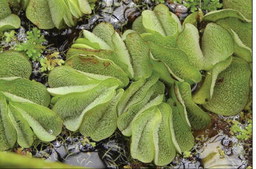Invasive plant spreading

Invasive plant spreading
Second sighting of Giant Salviniainstate
From the Arkansas Game & Fish Commission
www.agfc.com BRADLEY — Biologists with the Arkansas Game and Fish Commission have confirmed the presence of Giant Salvinia in a small portion of Lake Erling in Lafayette County. This is the second occurrence of the invasive plant in Arkansas, with the first being in Smith Park Lake in Miller County in 2017.
Giant Salvinia is a freefloating South American plant, similar in appearance to duckweed but much larger. It stays at the water’s surface and can rapidly cover a large area and choke out all life in the water beneath if left unchecked. According to Sea Grant Louisiana, under ideal conditions, a single plant of Giant Salvinia can multiply to cover 40 square miles of surface area in only three months.
The plant was identified by the Arkansas Game and Fish Commission’s Camden Regional Office.
Fisheries biologists then investigated the situation and confirmed the presence of the plant at the end of December.
Andy Yung, AGFC district fisheries supervisor said, “With it being an invasive species like Giant Salvinia, we want to do whatever we can to prevent it from being established in Arkansas.”
Yung says it’s particularly troubling to see the plant in Erling, a popular fishing destination, where it has the potential to hitch a ride on anglers’ boats, trailers and equipment and be unknowingly transported to other nearby lakes.
“With Lake Columbia not too far away, we’re very concerned that it could end up there,” Yung said. “Columbia is a water-supply reservoir, so if it gets there, our ability to use any sorts of herbicides is eliminated and we’ll really be fighting a losing battle.”
Yung says the most likely source of the infestation was from an angler or hunter transporting the plant to the lake accidentally after boating in an area where the plant had already become established.
Eric Brinkman, AGFC district fisheries supervisor in the AGFC’s Hope Office, says this also was a likely scenario for the states’ first occurrence of the plant in 2017 in his district.
“We hunt and fish too, and it’s really easy to see how a small bit of the plant can get stuck on a boat trailer, in a prop or even hang on to decoys, decoy weights and other equipment duck hunters use,” Brinkman said.



Share